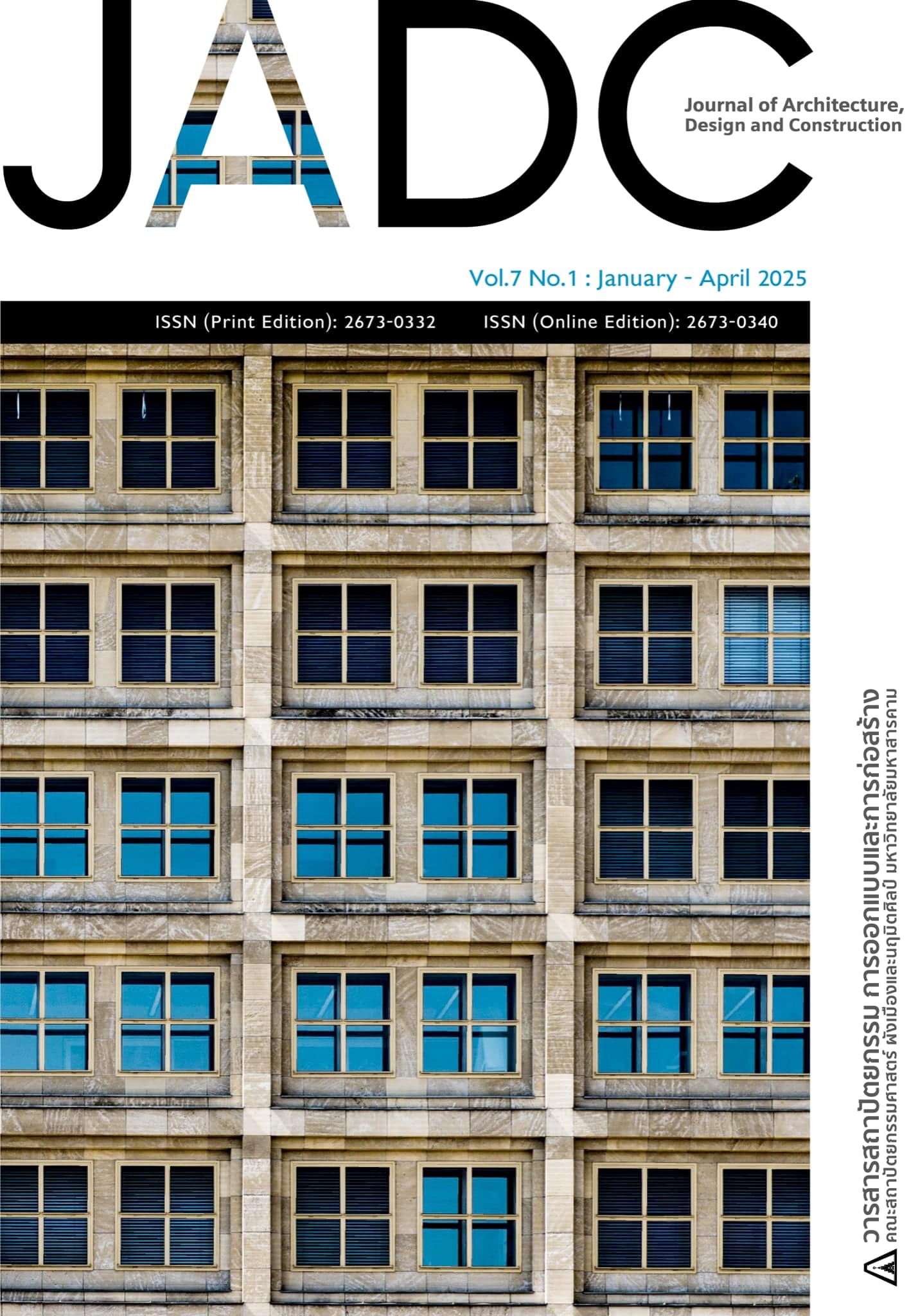Arch Café and Studio as the Third Place in Buriram Rajabhat University
Main Article Content
Abstract
Arch Café & Studio is a place that supports activities and places outside the classroom for students in the field of architectural technology, apart from their homes and classrooms. This study examine the relationship between people and places in the third place dimension, which is a process of environmental psychology through the third place theory. A quantitative research method was used to examine the third place, activities, and characteristics leading to the third place of Arch Café & Studio. The results of the study found that Ach Café & Studio is a third place with activities for relaxation, work, and socializing, with 8 characteristics consistent with Ray Oldenberg’s third places. In addition, the flexibility, facilities, and freedom characteristics were found, leading to the characteristics of being the favorite place of students in the field of architectural technology. This study shows that the third place can be redefined based on an understanding of the behavior and needs of users as important factors, and is a guideline for adapting the usable space to support the lifestyle of modern society, which will help develop and promote people’s quality of life in the future.
Downloads
Article Details

This work is licensed under a Creative Commons Attribution-NonCommercial-NoDerivatives 4.0 International License.
The articles published in the Journal of Architecture, Design, and Construction are the intellectual property of the Faculty of Architecture, Urban Planning, and Fine Arts, Mahasarakham University.
References
ณัฐณิชา โอภาสเสรีปาดัง. (2564, 28 พฤษภาคม). Central Perks-เรียนรู้ผ่านมุมมองซีรีส์ดังตลอดกาลอย่าง Friends. Citycracker. https://citycracker.co/intangible-city/central-perks-friends/
น้ำทิพย์ องอาจวาณิชย์. (2559). แนวทางการประเมินทักษะแห่งศตวรรษที่ 21. วารสารศึกษาศาสตร์ มหาวิทยาลัยทักษิณ, 16(2), 1–11.
ประสงค์ พรหมเมตตา. (2563, 22 พฤษภาคม). ทักษะในศตวรรษที่ 21. https://is.gd/gUm5Y1
ปาริฉัตร คำวาส. (2564, 2 กุมภาพันธ์). The 4th Space. https://readthecloud.co/gmw-experience-center/
ปุณณ กาญจนะโภคิน. (2565, 26 มกราคม). Jim Thompson Art Center อาร์ตเซนเตอร์แห่งใหม่ ที่ออกแบบอย่างยั่งยืนและตั้งใจเป็นพื้นที่สาธารณะทางศิลปะที่ผูกมิตรกับผู้คนและเมือง. The Cloud. https://readthecloud.co/jim-thompson-art-center/
พีรดร แก้วลาย และ ทิพย์สุดา จันทร์แจ่มหล้า. (2561). สภาพแวดล้อมเพื่อการเรียนรู้สาธารณะรูปแบบใหม่: การเปลี่ยนกระบวนทัศน์ของการเรียนรู้และผลกระทบที่มีต่อรายละเอียดโครงการ ที่ว่าง และสถาปัตยกรรมศูนย์ความรู้ร่วมสมัย. JARS, 15(2), 135–152. https://doi.org/10.56261/jars.v15i2.167939.
วีซานา อับดุลเลาะ และ วุฒิชัย เนียมเทศ. (2020). การจัดสภาพแวดล้อมการเรียนรู้เพื่อส่งเสริมทักษะการเรียนรู้ในศตวรรษที่ 21 “แนวคิด ทฤษฎี และแนวทางปฏิบัติ”. Princess of Naradhiwas University Journal of Humanities and Social Sciences, 227–245.
สมศักดิ์ เอี่ยมคงศรี. (2561). การจัดการห้องเรียนในศตวรรษที่ 21. ทริปเพิ้ล เอ็ดดูเคชั่น.
Bruxvoort, D. (2017, October 12). Library as third place: A strategic framework. Sconul. https://www.sconul.ac.uk/SCONULDownloadController/Download?iType=1&iID=351&cGUID=ce9370bb-7976-460d-a899-89983c52a72f&cTempLocation=
Das, D. (2008). Urban quality of life: A case study of Guwahati. Social Indicators Research, 88(2), 297–310.
Degroot, D. (2020, February 2). Creating third place spaces at church. https://info.aspengroup.com/hs-fs/hub/288364/file-1210704834-pdf/Downloadable_Resources/Creating_Third_Spaces__Aspen_Group.pdf?hsCtaTracking=556b3c9b-23af-4a65-a2b8-d8792f2b9ec3%7C62f7e8cc-2047-4931-8b26-449a0836344f
Glover, T. D., & Parry, D. C. (2009). A third place in the everyday lives of people living with cancer: Functions of Gilda’s Club of Greater Toronto. Health and Place, 15(1), 97–106.
Huyser, J., & Fridsma, S. (2006, February 2). Steve Fridsma on the Church as a Third Place. https://worship.calvin.edu/resources/articles/steve-fridsma-church-third-place
Jeffres, L. W., Bracken, C. C., Jian, G., & Casey, M. F. (2009). The impact of third places on community quality of life. Applied Research in the Quality of Life, 4(4), 333–345.
Lukito, Y. N., & Xenia, A. P. (2017). Café as third place and the creation of a unique space of interaction in UI campus. Earth and Environmental Science, 99.
McCarter, J., Boge, G., & Darlow, G. (2001). Safeguarding the world’s national treasures. Science, 294, 2099–2101.
Morehart, P. (2016, May 4). Library space planning: The third place. The Library Incubator. https://www.acohen.com/blog/library-space-planning-the-third-place/
Myers, P. (2012). Going home: Essays, articles, and stories in honour of the Andersons. Oak Hill College.
Oldenburg, R. (1989). The great good place. Da Capo Press.
Oldenburg, R. (1999). The great good place: Cafes, coffee shops, bookstores, bars, hair salons, and other hangouts at the heart of a community (2nd ed.). Marlowe.
Oldenburg, R., & Brissett, D. (1982). The third place. Qualitative Sociology, 5(4), 265–284.
Slater, A., & Koo, H. (2010). A new type of third place? Journal of Place Management and Development, 2, 99–112.
Woldoff, R., Lozzi, D., & Dilks, L. (2013). Social transformation of coffee houses: The emergence of chain establishments and the private nature of usage. International Journal of Social Science Studies, 1(2), 205–218.

